Australia Will Wait Years To See The Advantages of Solar Thermal
Solar thermal power in Australia may not be commercially viable for another 20 years or more. Energy Minister Josh Frydenberg has supported the...
An ongoing interest in solar panels has pushed boundaries in the fields of technology and innovation. The latest development is the promising transparent luminescent solar concentrator currently being developed by a team of researchers from Michigan State University. The concentrator aims to generate power from solar panel windows without obstructing the view.
Solar power has the ability to replace non-renewable resources used to generate power. It’s sustainable and it eliminates several concerns including high energy prices, dependence on fossil fuel imports from a slowly declining list of exporting countries and environmental degradation.
The start of Rwanda’s solar power farm signifies a growing need for sustainable power resources and is an example of the monumental success of solar power to date. As the first solar power farm in East Africa, it stands on 18 hectares of land, produces 850 megawatts of power which is served to 15,000 homes. The technological and environmentally sustainable leaps that solar power has made since the first photovoltaic materials were made in 1932 is unprecedented.
Currently, 1 out of every 5 households in Australia has gone solar. The national retail value generated even by small power systems is $4.6 million a day which amounts to $1.6 billion a year. Not to mention the solar power industry creates 200-400 jobs for every 10 megawatts of solar power generated. It’s time to put solar power under the spotlight.
Although Charles Fritss built the first solid state photovoltaic material, Edmund Becquerel is credited as the first person to make photovoltaic cells in 1932. He first generated electricity by illuminating an electrode with different types of light, including sunlight. Below is an illustration of Becquerel’s experiment which led to the discovery of the photovoltaic effect and paved the way to the modern-day solar panel.
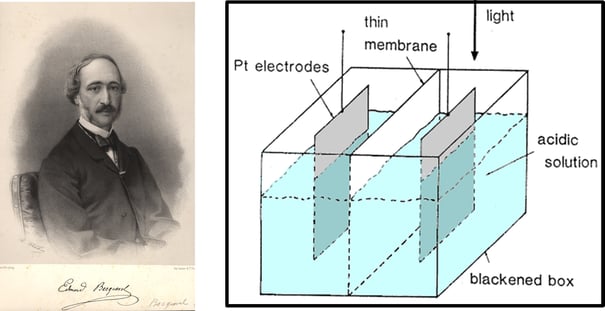
The next milestone in solar power history followed an accidental observation of electricity from light travelling through Selenium. Willoughby Smith made this lucky discovery in the 1860’s. Another Selenium observation by Adams and Smith in 1873 proved that solar radiation can be converted into energy.
Fritts later acknowledged that energy from the sun was a great possibility, even noting that excess energy could be used and stored in batteries. However it would take another 50 years from that point for solar power to be recognised as a promising field of scientific interest.
In 1954, Bell Laboratories demonstrated the first practical photovoltaic cell made of silicon invented by Daryl Chapin, Calvin Souther Fuller and Gerald Pearson. Below is a photograph of a cable repairman adjusting the Bell Solar Battery that was used to power the first solar-powered telephone call in Georgia, USA in 1955.
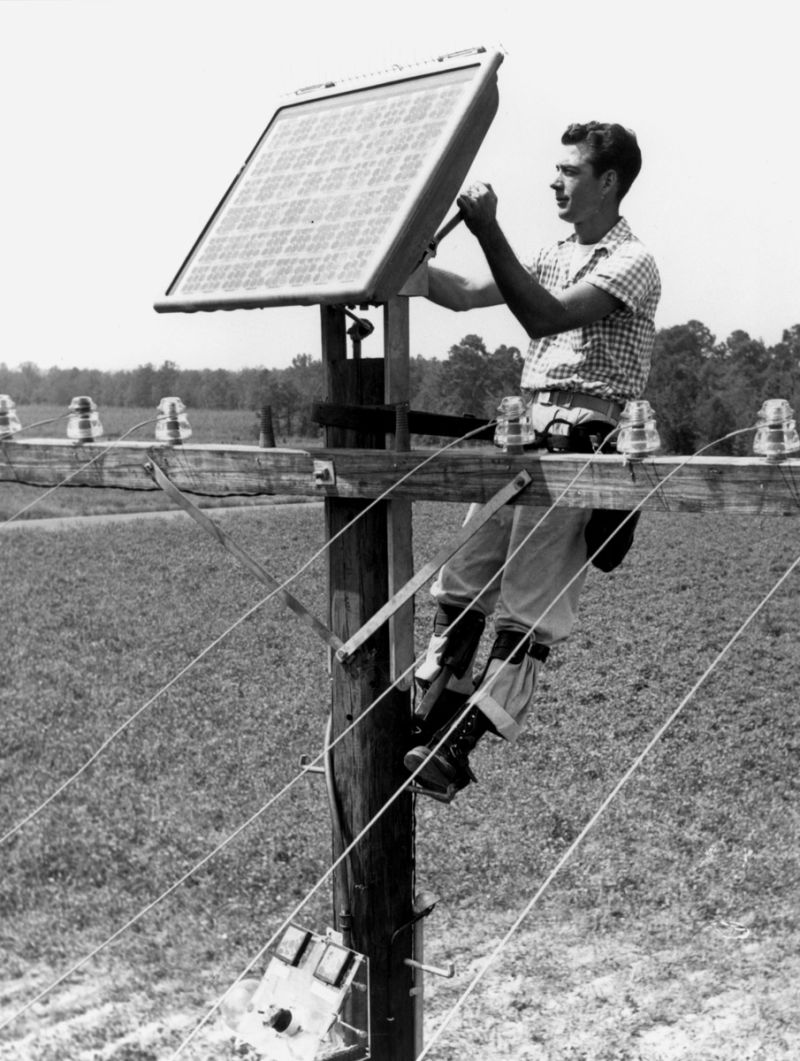
Other benchmarks in the development of solar panels and sustainable energy include the following events:
Since then, the world has been introduced to some cool solar-powered gadgets ranging from solar charging cellphones to a self-sufficient tent that can house you for 100 days off the grid.
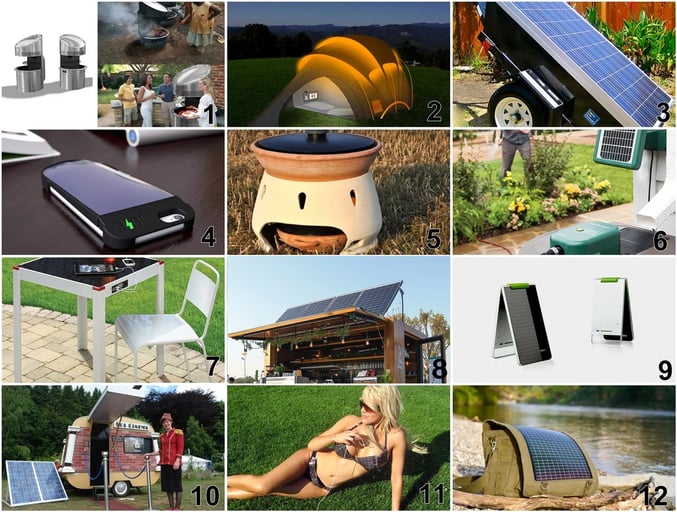
Not surprisingly, the demand of solar panels and solar power has risen. In the graph below you can see that the growth of photovoltaic capacity continue to rise. Two decades prior, the photovoltaic capacity was at 100 megawatts only which is a far cry from the 233,000 projection for 2015.
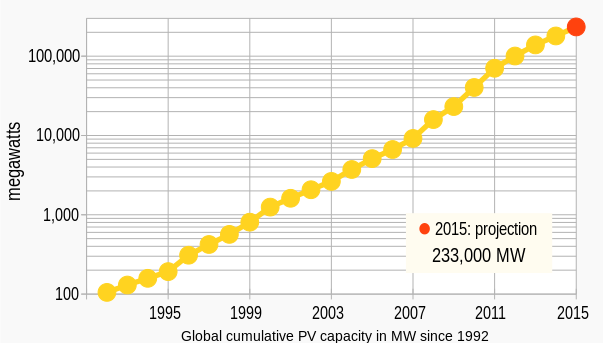
The most used photovoltaic cells are the silicon PV cells. These cells catch sun rays and turn them into electricity. They were first priced at $76 USD per watt produced in the 1970’s. As the popularity and use of solar power emerged as a viable and cheap alternative to power households and communities, the price per watt lowered to $.30 dollars.
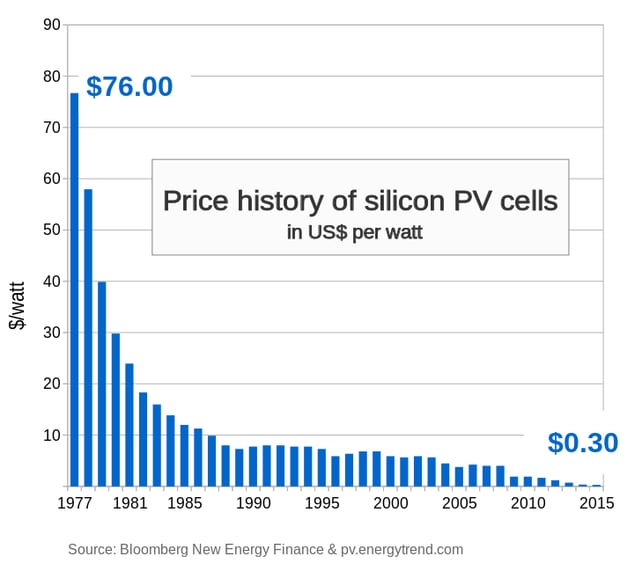
The demand for solar power, especially in homes and big companies veering towards sustainability, has been growing steadily since development in the 1970’s. But everything seemed to change in the early 90’s when the world focused on new technologies. Conglomerates and technology focused companies are even branching out into the solar panel business.
Although faced with setbacks from difficult legislations and fossil fuel supporters, the demand growth of photovoltaics and the projected cumulative capacity in megawatts also rose. In figures below, Europe is seen to be leading the demand followed by the Asia-Pacific region. By 2019, the global growth will be more than double the 2015 numbers.
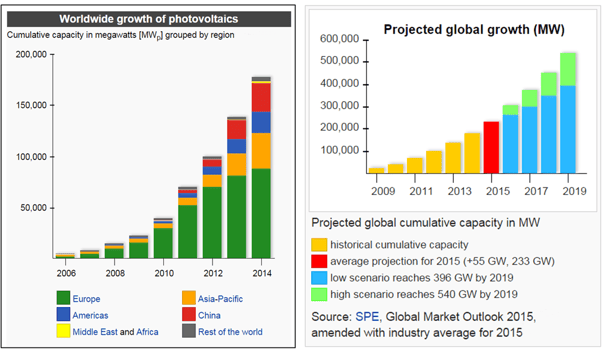
Evidenced by the spread of use, the solar panel market is finally getting some fierce competition which is an advantage for consumers. The efficacy of solar panels in powering homes, on-grid and off-grid, led to major movements of establishing solar power generation in both urban and rural areas. For urban areas, this is done to lower the expense of electrical prices while in rural areas, solar panels are sometimes the only source of energy. Solar energy works in rural areas and it removes the need for the complex process of laying out cables and energy loss from transport of electricity. Although solar panels may require a considerable price to set up, in the long run the amount spent can be returned in the form of savings.
Not all solar panels are made equal – aesthetically and performance-wise. The most notable types include monocrystalline silicon, polycrystalline silicon, building integrated photovoltaics, thin films, and solar thermal panels.
Almost 90% of the world’s solar panels are made from silicon. The more aligned the silicon molecules are in a panel, the better the solar cell can convert solar energy into electricity. This is called silicon purity although this is not the sole consideration and determining factor when choosing solar panels.
Monocrystalline panels have the best conversion efficiency to electricity. These panels have a higher silicon content which makes it more expensive although consumers may need fewer of these panels to produce power. Its efficiency rate is said to be at 15-20%
Mono-Si is also called single crystalline silicon and can be identified right away – it has an even external colour, looks uniform which indicates high purity silicon and is tapered to cylindrical ingots. This type requires less space and has the longest lifespan, prompting manufacturers to offer a warranty up to 25 years.
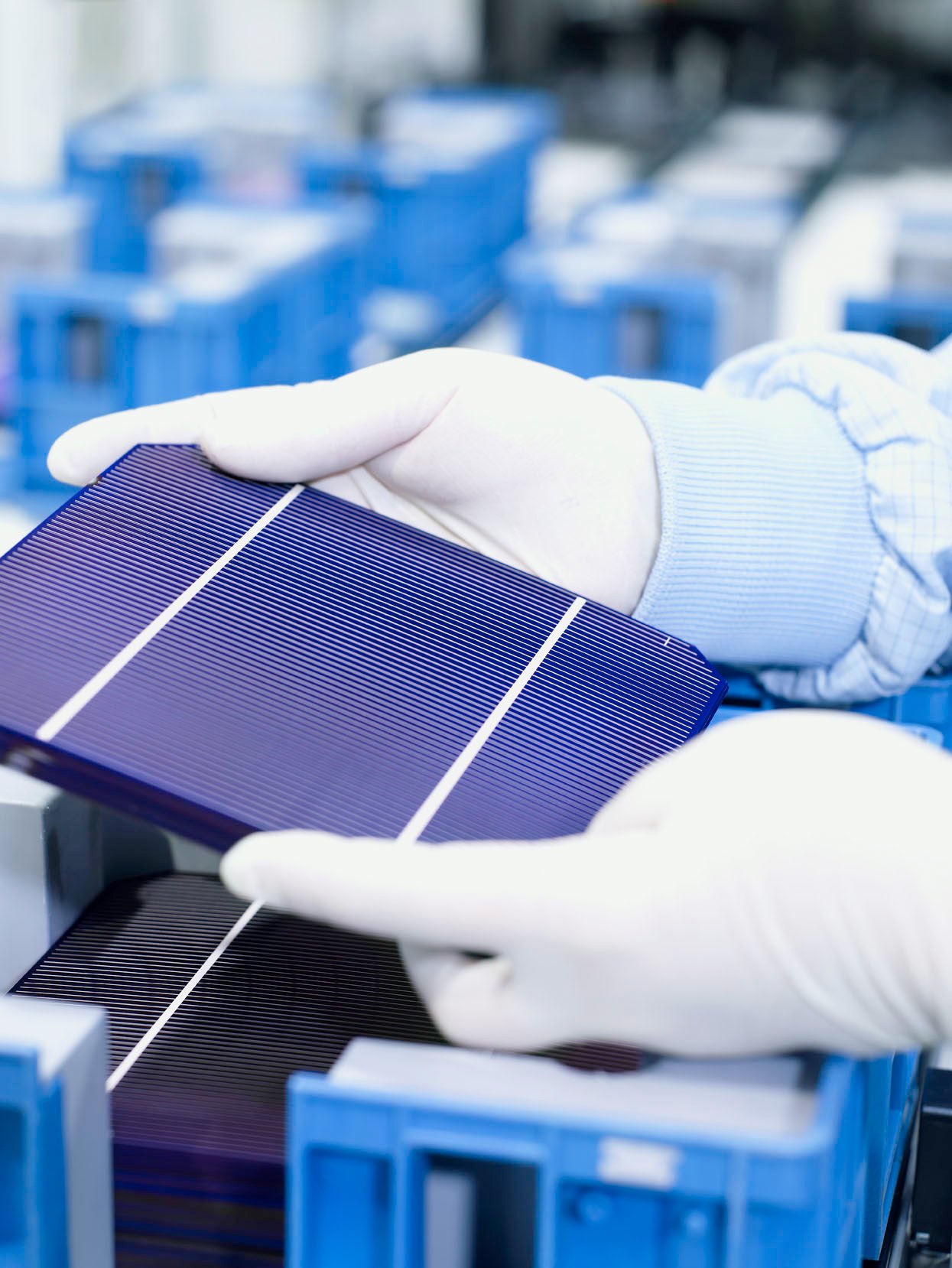
Polycrystalline silicon panels were first introduced to the public in 1981. It does not require the Mono-Si Czochralski process. P-Si instead requires raw silicon to be melted and poured into square moulds and then cut into square wafers as it cools.
Since the P-Si process is simple compared to Mono-Si, the former is much cheaper. P-Si efficiency has an average of 15% although this may vary in between manufacturers (Mitsubishi Electric has achieved 19.3%).
P-Si has low per panel cost which makes it in demand in the market especially for homeowners wishing to convert to solar sourced electricity. P-Si can also function for up to 25 years.
Among P-Si’s disadvantages includes a lower efficiency compared to Mono-Si and material fragility.
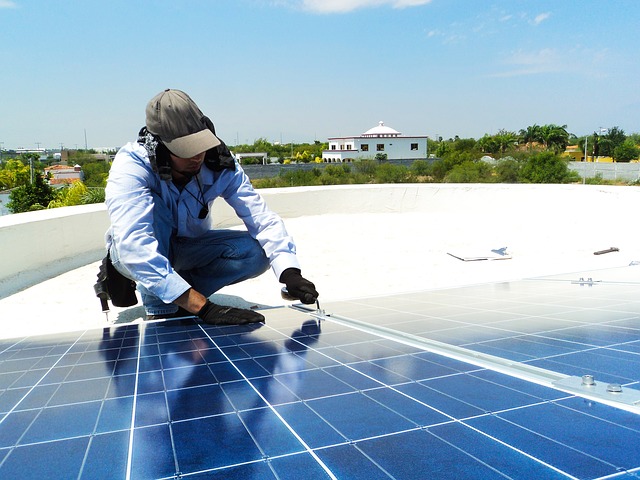
A second generation solar cell, thin-film solar films vary in thickness from nanometres to micrometres. Due to their thinness, this solar panel alternative is flexible, lightweight and exhibits less friction. Thin-films are usually integrated in BIPV materials. It is usually made of amorphous silicon, a much less high-grade silicon although some are also made of other semi-conductor materials (cadmium telluride and copper indium gallium diselenide).
The rise of thin-film in the market has been noted with the product now having a 25% share in the photovoltaic market. Since it is less expensive to produce, it has being steadily gaining popularity.
A new and exciting product incorporates photovoltaics in building materials. Photovoltaics are not just laid out on the roof; they can also be found in walls, windows, and roofing shingles.
With aesthetic considerations, panels are now seen beautifully integrated in building architecture. Builders and building owners can appreciate the functional and cost considerations of this alternative.

BIPV differs from the standard photovoltaic modules. Most BIPV may contain fewer cells especially in the roof tiles which means it has lower output voltage, thus requiring more of the product to be installed in order to be effective.
BIPV retrofitting is more expensive than other alternatives, however, if you take into consideration the fact that it is a two-in-one product, the cost may be worth it.
Solar thermal panels are used only when one wants to convert sun rays to heat. Its primary use is to heat water for homes. It’s certainly a cheap way to generate thermal energy, lowering household bills by up to 70%.
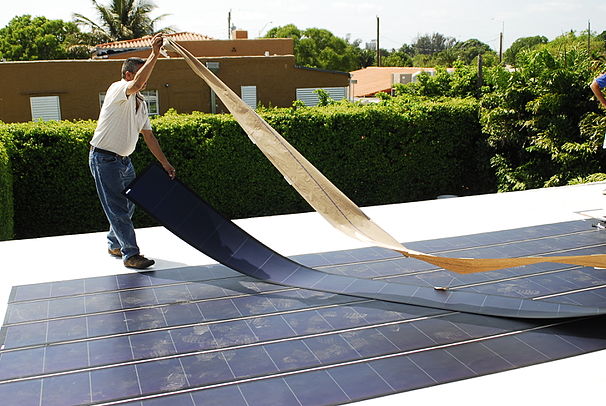
Like other panels, solar thermal panels are situated on the roof or in a place where it can absorb solar energy. There are also varying types including flat panel collectors, vacuum tube collectors, solar through panel and solar air panels. It is also cheaper compared to the PV panels and it has a 60-80% efficiency (vacuum type collectors work even on cloudy days).
Now that we’ve covered the types of solar panels, how does the technology actually convert light from the sun into usable energy? Check out this video:
When light from the sun hits the solar cells of a solar panel, the electrons within that cell move, starting the flow of electrons. An electrical circuit is created in the process when electrons are captured in the form of an electric current. This current can then be used to power appliances or heat water. The current produced is usually dependent on how much light strikes the cell.
Here’s a graphic from Pennsylvania State University outlining the process.
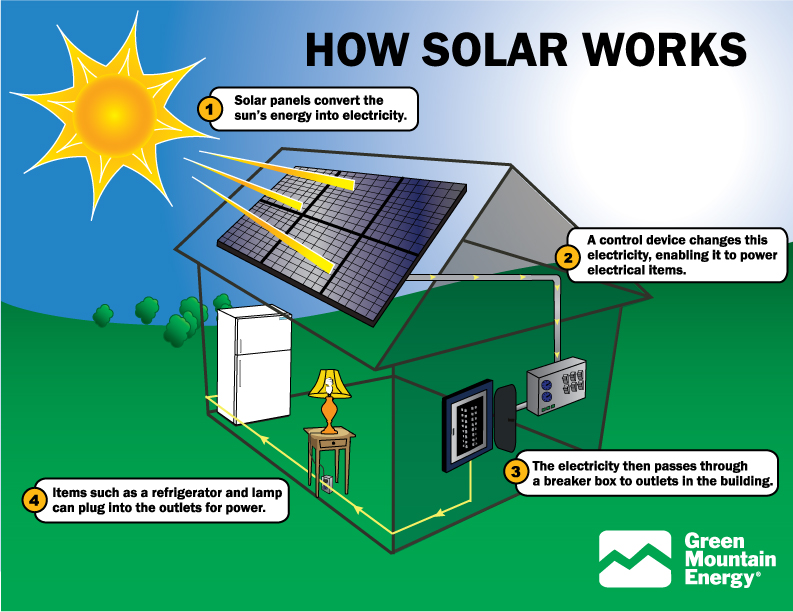
The solar industry grew by 41% in 2013 in the US. This growth was an incredibly positive result for environmental advocates and it meant more electricity generating solar plants, less carbon emissions and less fossil, coal and nuclear sourced electricity.
The truth is, it would only take a small area of the world’s surface covered in panels to supply the world’s electricity needs. In fact, all the roof space available in Australia can provide enough for the whole nation’s electricity needs. If this is done the right way, the world’s dependence on coal, nuclear and fossil sourced power could be reduced without hazardous waste. The energy used on the production and creation of solar panels could be paid back after a year.
Here are some other benefits of sun sourced electricity:
No matter how small your installation is, there will always be notable savings from your quarterly electricity bill. At first the price of the panel and installation is intimidating especially to homeowners. However, in the long run the return of investment is well worth it. According to data, the long-term ROI for solar energy is at 200%.
When solar panels are paid in cash, the payback period is even less. This depends on the country and the type of solar panels you have invested in.
Your home could be the most coveted property on the block once it goes on sale if it has already been retrofitted with solar panels. This is due to the fact that solar-powered homes have lower electricity costs and good home energy ratings.
Solar power is stable compared to the fluctuating and unreliable electricity prices of local utility. It’s an investment where you have to spend a little at the start but will reap the benefits in the long run.
Probably the next biggest benefit after the savings is the environmental advantage of going solar. With climate change threatening the world, the use of solar as an alternative will help eliminate the global warming effect. Compared to fossil fuel burning which releases greenhouse gases, carcinogen and carbon dioxide, solar power does not release any harmful emissions. Solar energy is safe, silent and lowers our carbon footprint.
Solar panels have a minimum of 20-25 years warranty and a guarantee of 80% output.
If the solar power production is supported, there will be enough energy to abolish the petroleum dependence of a city or even a small country.
In rural areas, the solar energy helps cut out dependence to expensive power that needs to travel from far-off sources. Even those that can’t be reached by cables or power lines can stand alone and set up their own power source from the sun.
Solar panels require little to no close maintenance. Cleaning the panels and making sure no objects are stuck in the panels is important, however. A yearly (or as needed) check-up for corroded wire or inverters breaking down can also be scheduled for a small cost.
Solar power is the most silent renewable energy source, which makes it a great option for homes and businesses.
Obviously, solar power is renewable. Sources simply can’t be depleted. It is easily available and limitless, at least for the next five billion years.
Currently, Australia holds the highest solar radiation per square meter compared to other continents making it the best solar resource in the world.
Solar powered gadgets and even solar dependent communities can become a reality. The future of solar power is a clean environment and limitless energy from the sun.
Check out this video to see what our solar future could look like:
For more information on solar power in the future, check out this comprehensive study from Massachusetts Institute of Technology – The Future of Solar Energy.
This article originally appeared on the XEN Life blog. It has been reproduced here with permission.

Solar thermal power in Australia may not be commercially viable for another 20 years or more. Energy Minister Josh Frydenberg has supported the...
Great news from Gizmodo as scientists at The Australian National University (ANU) have set a world record for efficiency for a solar thermal dish...
Scientists at the Australian National University announced that they have set a world record for efficiency for a solar thermal dish generating steam...